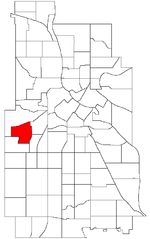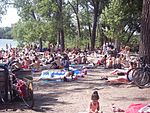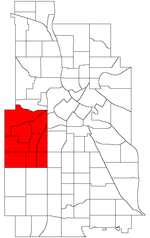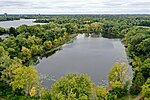Kenilworth Trail
Bike paths in MinnesotaParks in MinneapolisRail trails in MinnesotaShared-use paths in Minneapolis

The Kenilworth Trail is a paved bicycle trail in Minneapolis, Minnesota, United States. It runs nearly 1.5 miles (2.4 km) and acts as a connector between the Cedar Lake Trail in the north and the Midtown Greenway in the south. Like the Cedar Lake Trail, most of the route is composed of a triple-divided cycleway/pedway with a pair of one-way paths for bicycles and another path for pedestrians. On some maps, a southern segment of the Kenilworth Trail is called the Burnham Trail. The trail corridor has been considered the most highly trafficked in the Minneapolis park system.
Excerpt from the Wikipedia article Kenilworth Trail (License: CC BY-SA 3.0, Authors, Images).Kenilworth Trail
Burnham Road, Minneapolis Bde Maka Ska - Isles
Geographical coordinates (GPS) Address Nearby Places Show on map
Geographical coordinates (GPS)
| Latitude | Longitude |
|---|---|
| N 44.958055555556 ° | E -93.315 ° |
Address
Burnham Road
55405 Minneapolis, Bde Maka Ska - Isles
Minnesota, United States
Open on Google Maps










